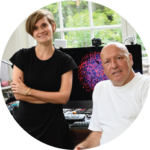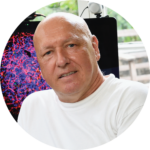Every Cell’s Story: Characterizing the activity of human iPSC derived-neurons in 2D and 3D cultures at high resolution
Abstract | Both 2D and 3D brain models derived from human induced pluripotent stems cells (hiPSCs) are emerging as promising tools for investigating brain development and disease progression, as well as to test drug toxicity and efficacy in-vitro. In order to adopt hiPSC-derived 2D and 3D neuronal networks for rapid and cost-effective phenotype characterization and drug screening, it is necessary to assess their cell type composition, gene expression patterns, and physiological function.
In this innovation showcase, our invited speakers will showcase studies where MaxWell Biosystems’ high-density microelectrode array (HD-MEA) platforms, MaxOne and MaxTwo, facilitated the characterization of the neuronal activity of hiPSC-derived neurons.
- Phenotyping neurodevelopmental and psychiatric disorders, specifically the effect of 16p11.2 copy number variation, with hiPSC-derived dopaminergic neurons
- Applications of the hiPSC-derived brain model called BrainSpheres in neurotoxicology and in modeling brain states, such as diseases and sleep
Overall, the presentations will provide an overview on how HD-MEA technology can efficiently advance research in 2D and 3D hiPSC-derived brain models and accelerate drug development for neurodegenerative diseases.
Watch the replay here
| Schedule in CEST | click here to convert to your timezone |
|---|---|
09:00 - 09:02  | Dr. Marie Obien VP Marketing & Sales, MaxWell Biosystems, Host of the session Opening Remarks |
09:02 - 09:10  | Dr. Urs Frey CEO, MaxWell Biosystems MaxWell Biosystems Welcome Address |
09:10 - 09:25   | Dr. Maria Sundberg Research Fellow, Boston Children’s Hospital, Harvard Medical School Talk | Phenotyping of neurodevelopmental and psychiatric disorders with human iPSC-derived dopaminergic neurons In recent years, the genetic causes of autism and schizophrenia have been studied intensively. In addition to monogenic deficits, deletions or duplications of specific chromosomal loci have also been associated with neurodevelopmental and psychiatric disorders. One of these regions is 16p11.2, which contains 29 protein coding genes, most of which are also expressed in the brain. Clinical studies have shown that deletion of 16p11.2 leads to severe developmental deficits, intellectual disability, and autism. On the other hand, patients with duplication of 16p11.2 locus have an increased risk of developing schizophrenia, bipolar disorder, depression and autism. Deficits in the dopamine signaling can cause behavioral problems and deficits in social interactions in the patients with autism and schizophrenia. To study the effects of 16p11.2 copy number variations on dopamine signaling we differentiated human iPSCs, with either a 16p11.2 duplication or deletion, into dopaminergic (DA) neurons in vitro. We characterized molecular and functional phenotypes of these neurons compared to healthy control neurons. For assessment of network activity we used a high-density micro-electrode array (MEA) platform and multi-well low-density MEA. To analyze the transcriptional gene expression changes in the DA neurons we did RNA sequencing. We detected that the cells carrying 16p11.2 deletion had an increased soma size, increased synaptic marker expression, and hyperactive DA-neuron networks compared to healthy control DA-neurons. Increased RhoA expression was also detected in the 16p11.2 deletion DA-neurons. Treatment of the neurons with a specific RhoA pathway inhibitor, Rhosin, rescued the network hyperactivation and the abnormal morphological development of the DA-neurons with 16p11.2 deletion. These results show that inhibition of RhoA pathway can serve as a potential therapeutic target for neurodevelopmental and neuropsychiatric disorders associated with 16p11.2 deletion. |
09:25 - 09:40   | Dr. Thomas Hartung Doerenkamp-Zbinden Chair, Johns Hopkins University Dr. Lena Smirnova Research Associate, Johns Hopkins University Talk | Microphysiological and micropathophysiological systems to address developmental neurotoxicity and neurological disorders The main goal of our research at Center for Alternatives to Animal Testing is to develop a testing strategy, based on our human 3D iPSC-derived brain model for fast and robust assessment neurotoxicological potency of the chemicals and chemical mixtures. We showed earlier developmental neurotoxic effects of the pesticides (rotenone, chlorpyrifos) heavy metal mixtures and the antidepressant paroxetine in this model. Our iPSC-derived BrainSphere model covers many key features of brain homeostasis, which allows multiplexing of assays. Currently we are developing an assay using CRISPR/Cas9 knock-in fluorescent tags for neural markers (6-in-1 BrainSphere assay). This should increase neurotoxicity testing throughput. In addition using iPSC with autistic genetic background, we address the role gene environmental interactions (GxE) in disease manifestation and severity. In collaboration with School of Engineering, we are developing a 3D multielectrode array system, where the brain organoids are caged in the 3D multi-electrode shell, which allows us to perform recording in 3D, similar to human EEG. Taking together, iPSC-derived BrainSpheres represent a versatile tool not only for mechanistic understanding of diseases, but also screening chemicals and open the doors for countermeasure research. |
09:40 - 09:50    | Dr. David Pamies Junior Lecturer, University of Lausanne Talk | Application of MaxTwo platform in BrainSpheres model The developing nervous system is difficult to model in vitro. The complexity of the nervous system, the multitude of cells and the duration of this process represent tremendous challenges. However, in order to understand aspects of these processes and possible perturbations in disease or due to toxic or traumatic insults, it is necessary to make such cell models available. With the advent of stem cells, this field has started to boost a development of 3D models, which promise to represent neural development and the possible targets of disruption. However, this model present certain limitations due to their complexity. Many in vitro endpoints to assess tissue insult are based on biochemical and morphological changes assays and are not adapt for 3D cultures. However, functionality assays are very important, notably when screening compounds with the potential to disrupt the nervous system; this is because the disruption of neuronal excitability produces substantial and rapid disruption of nervous system physiology and often this occurs in the absence of other biochemical or morphological changes. Here, we present the application of a 3D human iPSC-derived brain model (also called BrainSpheres) for two different projects using high density multielectrode array (MaxTwo). |
| 09:50 - 10:00 | Q&A Session All speakers |
Speakers | Short Bio
Speaker Short Bio



Dr. Maria Sundberg
Research Fellow, Boston Children’s Hospital, Harvard Medical School
Maria Sundberg is an experienced scientist with a background in stem cell science and neurobiology. Her current focus is on modeling neurodevelopmental and psychiatric disorders with patient derived cells. Dr. Sundberg received her PhD in Stem Cell and Tissue Engineering from the Institute of Biomedical Technology at the University of Tampere in Finland in 2011. Her thesis studies focused on development of oligodendrocyte differentiation protocols from human pluripotent stem cells and optimization of neural cell transplantation methods for treatment of spinal cord injuries. She did her post-doctoral training in the Mclean Hospital/Harvard Medical School, where she focused on differentiation of dopaminergic neurons and development of cell therapy protocols for treatment of Parkinson’s Disease (Sundberg et al., 2013, Stem Cells).
Since 2014, Dr. Sundberg has been working as a research fellow in the Boston Children’s Hospital, Department of Neurology, F. M Kirby Center for Neurobiology/Harvard Medical School. During this time, she has studied differentiation of human pluripotent stem cells into cerebellar lineage and Purkinje neurons. She has characterized various disease phenotypes of the patient-derived neurons related to neurodevelopmental disorders of Tuberous Sclerosis Complex and autism. Her studies have shown that TSC2-deficient Purkinje neurons have increased mTOR pathway activation, reduced expression of FMRP and reduced excitability in the cell culture, and specific mTOR inhibitor rescued these deficits in the neurons (Sundberg et al., 2018, Molecular Psychiatry).
Recently, Dr. Sundberg has studied rare genetic copy number variations of 16p11.2 associated with autism and neuropsychiatric disorders. In these studies, she has characterized disease phenotypes of dopaminergic neurons derived from iPSCs harboring CRISPR-cas9 edited 16p11.2 copy number variations. By using various microelectrode array methods she has discovered that increased RhoA pathway activation leads to hyperactivation of dopaminergic neuron networks in neurons with 16p11.2 deletion, and RhoA pathway inhibition rescued these deficits in vitro(Sundberg et al., 2021, Nature Communications). In total, Dr. Sundberg has over 15 years of experience in disease phenotyping of human pluripotent stem cell derived neurons with various cell culturing techniques.
| Institutional website | Publications | LinkedIn |


Dr. Thomas Hartung
Doerenkamp-Zbinden Chair, Johns Hopkins University
Thomas Hartung, MD PhD, is the Doerenkamp-Zbinden-Chair for Evidence-based Toxicology in the Department of Environmental Health and Engineering at Johns Hopkins Bloomberg School of Public Health, Baltimore, with a joint appointment at the Whiting School of Engineering. He also holds a joint appointment for Molecular Microbiology and Immunology at the Bloomberg School. He is adjunct affiliate professor at Georgetown University, Washington D.C.. In addition, he holds a joint appointment as Professor for Pharmacology and Toxicology at University of Konstanz, Germany; he also is Director of Centers for Alternatives to Animal Testing (CAAT, http://caat.jhsph.edu) of both universities. CAAT hosts the secretariat of the Evidence-based Toxicology Collaboration (http://www.ebtox.org), the Good Read-Across Practice Collaboration, the Good Cell Culture Practice Collaboration, the Green Toxicology Collaboration and the Industry Refinement Working Group. As PI, he headed the Human Toxome project funded as an NIH Transformative Research Grant. He is Chief Editor of Frontiers in Artificial Intelligence. He is the former Head of the European Commission’s Center for the Validation of Alternative Methods (ECVAM), Ispra, Italy, and has authored more than 590 scientific publications (h-index 99).
| Institutional website | Publications | LinkedIn | Twitter


Dr. Lena Smirnova
Research Associate, Johns Hopkins University
Lena Smirnova received her Diploma (Master equivalent) in Radiobiology and Environmental Medicine from the International Sakharov Environmental University (ISEU), Minsk, Belarus. She got a Biology Ph.D. degree in 2007 from Charite University, Berlin, focused on the role of microRNA in developmental neurotoxicity. From 2008 and 2012, Dr. Smirnova held a PostDoc Position at the Center for Alternative to Animal Methods, Federal Institute for Risk Assessment, Berlin, working on the role of microRNA in developmental neurotoxicity. At John Hopkins University, she is currently the head of the education program and a researcher at Center for Alternatives to Animal Testing, focused on gene environmental interactions in autism using stem cell-derived 3D brain model.
| Institutional website | Publications | LinkedIn |



Dr. David Pamies
Junior Lecturer, University of Lausanne
David Pamies is a Research Fellow / Junior Lecturer at the Department of Biomedical Science on the Lausanne University. He got his masters degree in Bioengineering and Ph.D. in the Miguel Hernandez University. Since his PhD, his research has been mainly focused on the use of in vitro systems to study neurotoxicology and developmental neurotoxicology. He also was working one year in the IHCP (European Commission). During his trainee period at the European Commission Joint Research Center (JRC), he was working in new 3D models to assess developmental neurotoxicity (DNT). Afterwards, he joined the Center for Alternatives to Animal Testing in January 2013, where worked for 5 years, first as a postdoc and after as a research associated on developing and application of an iPSC-derived 3D human brain microphysiological system to study DNT, encephalitis, virus infection, Parkinson disease (PD) between others. Now, Dr. Pamies is working on the use of new in vitro technologies to quantify adverse outcome pathways (AOPS) to help regulatory decision-making between other projects.
| Institutional website | Publications | LinkedIn | Twitter |
 English
English


